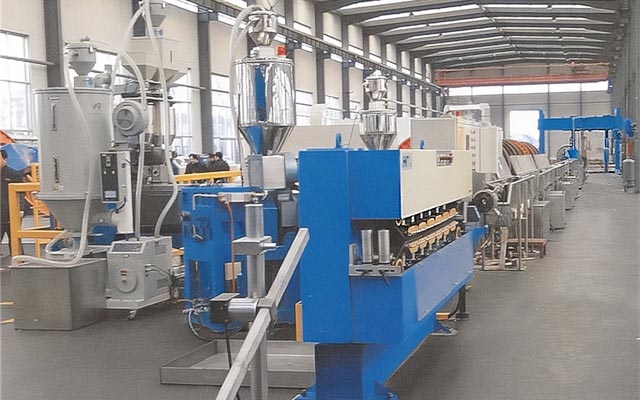Model 70-120Screw Diameter φ70-120L/D Ratio 26:1/25:1Extrusion Output 140-450 kg/hMain Motor 40-165 KWOutlet Diameter 2-80 mmSpeed 80-300Application VV low-voltage power cable
VV Power Cable Extrusion Line
VV cable was a very common type of low-voltage power cable in the past, and its name derives from its insulation and sheath materials.
Meaning of the LettersThe first V: Indicates that the insulation material of the cable is polyvinyl chloride (PVC).
The second V: Indicates that the sheath material of the cable is also polyvinyl chloride (PVC).
Main CharacteristicsAdvantages:
Low Cost: PVC material is inexpensive, making VV cables highly cost-effective.
Chemical Resistance: Offers certain resistance to acids, alkalis, and oils.
Mature Technology: Long history of production and use, with well-established techniques.
Good Mechanical Properties: Provides a certain degree of hardness and wear resistance.
Disadvantages:
Lower Current-Carrying Capacity: Compared to YJV (cross-linked polyethylene insulated) cables, VV cables have a lower long-term permissible operating temperature (70°C vs. 90°C).
As a result, for the same cross-sectional area, VV cables have a lower current-carrying capacity (ability to carry current).
Poor Environmental Performance: PVC emits large amounts of black smoke and toxic, corrosive halogen gases (such as hydrogen chloride) when burned, which hinders evacuation and rescue efforts during fires. This is one of the main reasons for its gradual replacement.
Poor Heat Resistance: The maximum operating temperature of 70°C limits its application in higher-temperature environments or scenarios requiring higher current-carrying capacity.
VV Power Cable Extrusion Line
The VV low-voltage power cable extrusion production line is a complete set of equipment specifically designed for manufacturing insulated cores and protective sheaths of power cables rated at 0.6/1 kV and below. Its core process involves melting solid plastics (such as PVC or XLPE) through heating and pressurization, then continuously and uniformly coating conductors (copper/aluminum wires) or assembled cable cores. After cooling and solidification, a smooth, dense, and uniformly thick insulating layer or protective sheath is formed.
Core Components
The VV power cable extrusion production line is a highly coordinated automated system, primarily consisting of the following major components:
Pay-off Unit:Supports and releases the conductor or cable core, providing stable and controllable tension to prevent thinning or twisting of the conductor.
Preheater:Heats the conductor before it enters the die head to remove moisture, reduce internal stress, and improve adhesion between the plastic and the conductor.
Extruder:Screw: Conveys, compacts, melts, and homogenizes the plastic.
Barrel: Heats and cools the plastic.
Drive Motor: Provides power to the screw.
Die Head: Connects the extruder to the die.
Die (Tip and Die): Determines the thickness, concentricity, and shape of the extruded layer.
Cooling Trough:Rapidly cools and solidifies the high-temperature cable. Typically features segmented temperature control to ensure material stability and avoid internal stress.
Haul-off Unit:Provides the driving force for the production line. Its speed must be extremely stable, as it is critical for ensuring uniform extrusion thickness.
Spark Tester:An online quality inspection device that applies high voltage to the insulating layer to detect defects such as pinholes or impurities, triggering alarms and marking the locations.
Take-up Unit:Winds the finished cable neatly onto a reel, maintaining constant tension and synchronizing with the haul-off speed.
Control System:Uses a PLC / industrial computer to centrally control all parameters (temperature, speed, tension, etc.), ensuring stable and reproducible production.
VV Power Cable Extrusion Line Datasheet
| Model |
70 |
80 |
90 |
100 |
120 |
| Screw Diameter (mm) |
φ70 |
φ80 |
φ90 |
φ100 |
φ120 |
| Screw L/D Ratio |
26:1 |
26:1 |
26:1 |
25:1 |
25:1 |
| Extrusion Amount (kg/hr) |
140 |
200 |
250 |
320 |
450 |
| Outlet Wire (mm) |
2-15 |
3-25 |
5-35 |
8-60 |
10-80 |
| Total Power (KW) |
40 |
55 |
63 |
120 |
165 |
| Production Speed(Max., m/min) |
300 |
200 |
200 |
100 |
80 |
| Take-up Spool |
500/800 |
800/1250 |
800/1600 |
1000/2000 |
2000/2500 |
| Storage Length |
240 m |
200 m |
180 m |
0 |
0 |
VV Power Cable Extrusion Line Application
The VV low-voltage power cable extrusion production line is a complete set of equipment specifically designed for producing VV cables & insulation cores and sheaths of power cables with rated voltage of 0.6/1kV and below. The details are as follows:
Conductor Insulation
Function: Extrudes insulating material onto copper or aluminum conductors to form the primary insulation layer.
Common Materials: Cross-linked polyethylene (XLPE), polyethylene (PE), polyvinyl chloride (PVC), etc.
Requirements: Uniform thickness, high concentricity, absence of impurities, and no microvoids. The insulation extrusion process for high-voltage cables demands the highest technical precision.
Sheathing Extrusion
Function: Extrudes a protective sheath over the assembled cable core.
Purpose: Provides mechanical protection, corrosion resistance, moisture resistance, UV resistance, flame retardancy, etc.
Common Materials: Polyvinyl chloride (PVC), polyethylene (PE), polyolefins, etc.


